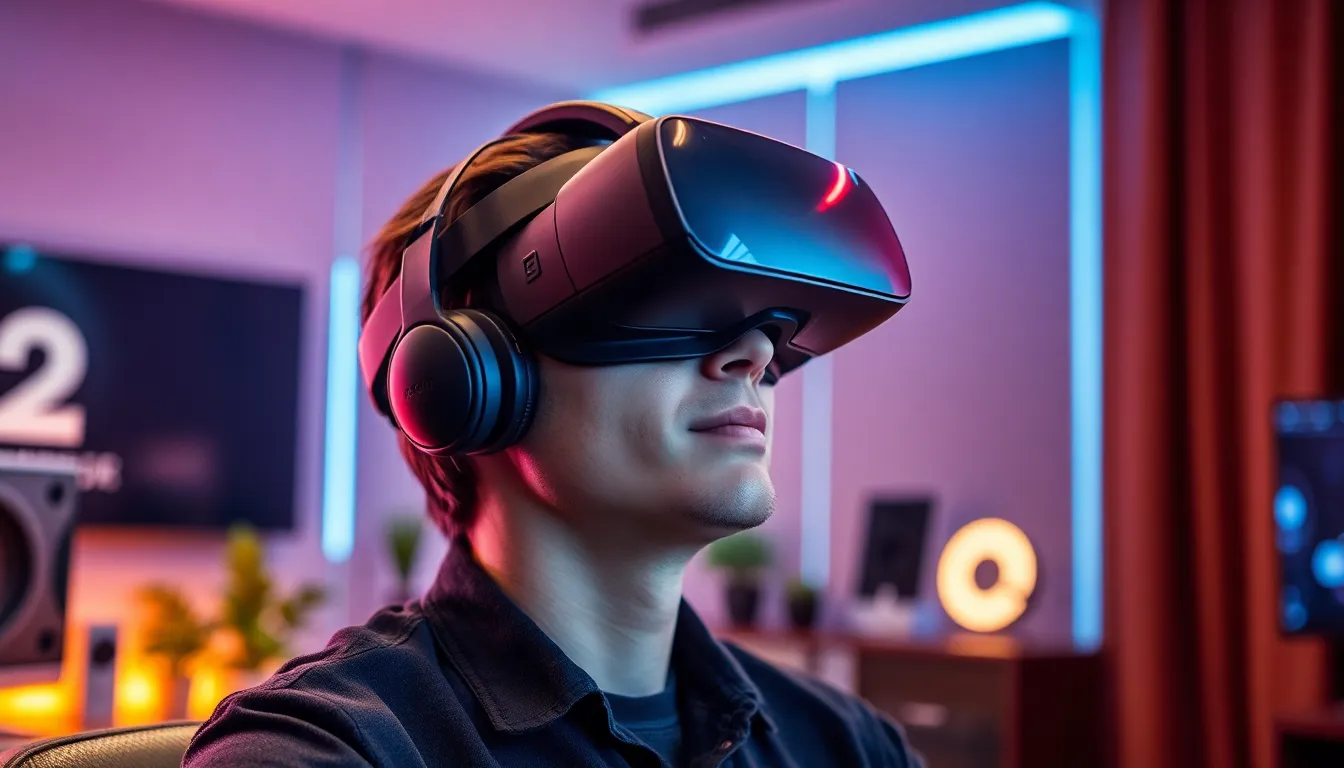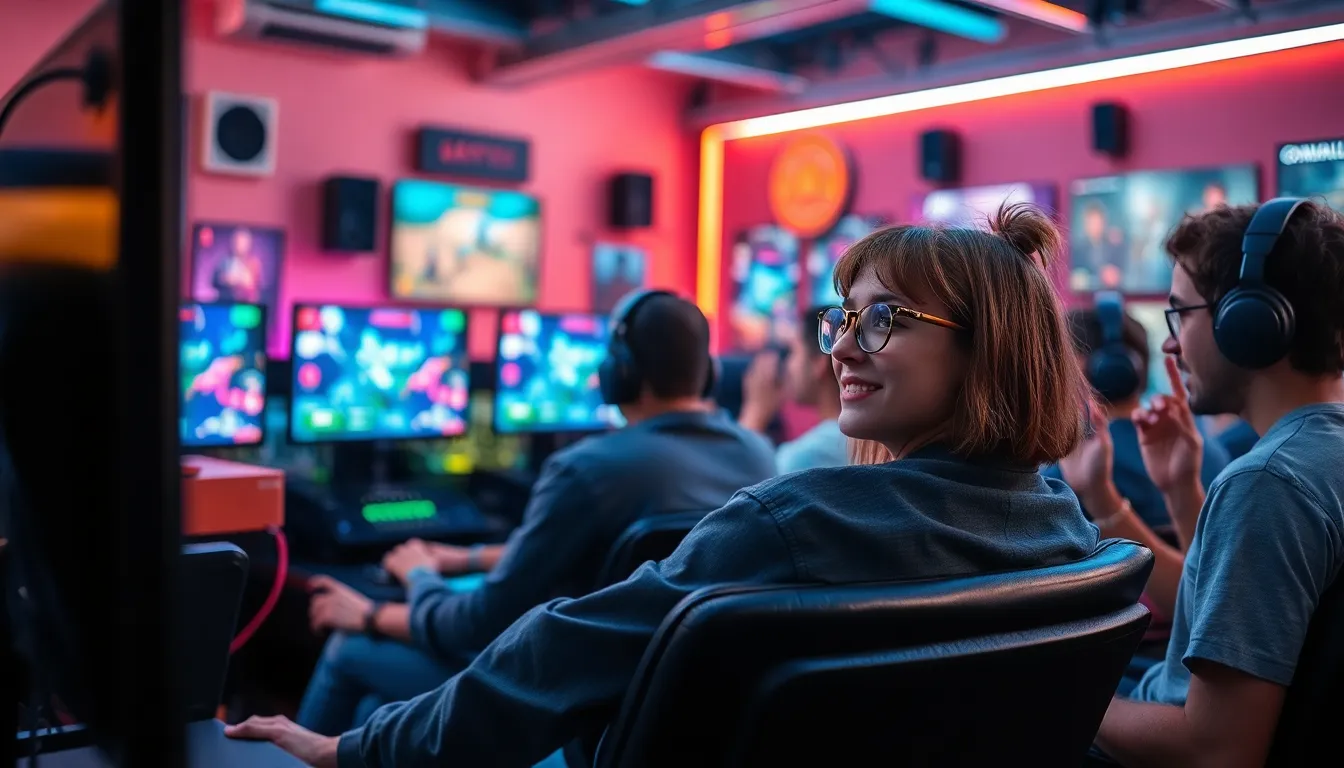Table of Contents
ToggleVirtual reality gaming is no longer just a futuristic dream; it’s a thrilling reality that’s reshaping the way players experience their favorite worlds. From battling dragons to exploring alien landscapes, VR technology is taking immersion to a whole new level. Imagine dodging virtual fireballs while still managing to avoid stepping on your cat—now that’s multitasking!
Overview of VR Gaming Developments
VR gaming has rapidly evolved since its inception, with several technological advancements enhancing player experiences. Innovations in hardware, such as improved headsets, allow for greater immersion and comfort during extended gameplay sessions. Companies like Meta, Sony, and HTC consistently push the boundaries, unveiling devices with higher resolutions and advanced tracking capabilities.
Developers are integral to VR’s growth, creating engaging titles that appeal to diverse audiences. Popular games like “Half-Life: Alyx” and “Beat Saber” showcase VR’s potential, providing unique interactions and intense gameplay. These titles often incorporate elements that challenge players both mentally and physically.
Platforms also play a crucial role in shaping the VR landscape. Services like SteamVR and Oculus Store offer extensive libraries, giving gamers access to a wide range of VR experiences. Accessibility and affordability have improved, enabling more players to explore virtual worlds.
Moreover, social interactions within VR environments have transformed significantly. Multiplayer games and VR chat platforms foster community and connectivity among users. Events such as VR game shows and tournaments further promote engagement and excitement within the gaming community.
Investment in VR technology has surged, with funding for startups and established companies on the rise. As hardware and software continue to improve, VR gaming’s future looks promising. These developments suggest that immersive experiences could soon become mainstream in the gaming industry.
Recent Innovations in VR Technology

Recent progress in virtual reality technology pushes gaming experiences to new heights. Developers continue to enhance immersive gameplay through focused innovations in hardware and software.
Improved Hardware Features
New headset designs include lightweight materials, providing extended comfort during lengthy sessions. Enhanced resolution capabilities reach 4K and beyond, delivering remarkable detail and clarity. Increased field of view creates a more encompassing visual experience. Advanced tracking systems utilize external sensors, offering precise movements and reducing latency. Battery life improvements ensure longer playtimes without interruptions.
Enhanced Software Capabilities
Software advancements feature more intuitive user interfaces, simplifying navigation within applications. AI integration provides dynamic responses, personalizing gameplay for individual users. Enhanced graphics engines support realistic environments, immersing players in stunning visuals. Multiplayer experiences have improved through smoother online interactions, fostering seamless collaboration. Cloud gaming technology enables instant access to vast libraries of VR content anytime, anywhere.
Impact of VR on Gaming Experience
Virtual reality significantly enhances the gaming experience by immersing players in dynamic environments.
Immersion and Engagement
Immersion plays a critical role in VR gaming. Through realistic graphics and spatial audio, players get a multimedia experience that heightens their involvement. Engaging with in-game elements becomes seamless, as actions feel more natural, like grasping objects or navigating landscapes. Players often report a genuine sense of presence, as if they truly inhabit the game’s world. Studies indicate that immersion can boost player satisfaction, leading to longer gaming sessions. The more engaging the content, the more likely players stay invested in the experience, drawn back to explore every detail.
Social Interaction in VR Gaming
Social interactions transform in virtual reality settings. Multiplayer experiences allow players to connect in real-time and share adventures in the same virtual space. Engaging in conversations through avatars fosters a sense of presence and connection. These environments often mimic real-life interactions, enhancing feelings of camaraderie. Players use VR chat platforms to build communities, creating lasting friendships and shared experiences. Research suggests that social presence in VR can strengthen relationships and improve teamwork within games. Enhanced communication tools also aid in collaboration, making multiplayer gameplay more enjoyable and interactive.
Future Trends in VR Gaming
The future of VR gaming promises exciting developments that will elevate immersion and gameplay experiences. Innovations in technology and content continuously reshape the landscape.
Advancements in AI Integration
AI integration sets the stage for more intelligent virtual environments. Dynamic characters will adapt to player actions, creating unique and personalized experiences. Additionally, procedural generation techniques will allow for the creation of expansive game worlds, ensuring each playthrough feels fresh. AI-driven narrative systems can respond to player choices, enhancing storytelling capabilities. With these developments, gamers can expect deeper emotional connections to the characters and environments.
Expansion of VR Genres and Platforms
The expansion of VR genres showcases innovative gameplay across various platforms. Adventure and horror genres are gaining traction, enriched by immersive storytelling and interactivity. Moreover, social VR experiences are becoming more prevalent, bringing players together in shared environments. Music and rhythm games are evolving, utilizing VR technology to create engaging experiences. Cross-platform functionality is enhancing accessibility, enabling users to join in seamlessly regardless of their device. As these genres grow, players will find diverse options that cater to different preferences and styles.
Challenges Facing VR Gaming Developments
Several challenges hinder the growth of VR gaming. Affordability and accessibility remain significant barriers.
Affordability and Accessibility
High costs associated with VR hardware often restrict access for potential users. Headsets from brands like Meta and HTC vary in price from $300 to over $1,000, making them less accessible for many gamers. Moreover, additional requirements such as powerful gaming PCs increase financial strain. Many consumers may hesitate to invest in VR due to these expenses. Accessibility issues also emerge for individuals with disabilities, who may struggle to find adaptive hardware or software tailored to their needs. Industry stakeholders must prioritize inclusive design to create experiences that cater to a broader audience.
Health and Safety Concerns
Health risks associated with VR gaming present challenges that developers must address. Prolonged use of VR headsets can cause discomfort, leading to issues such as eye strain or motion sickness. Reports indicate that nearly 40% of users experience some form of VR motion sickness, which can discourage extended play sessions. Additionally, spatial awareness poses a safety concern, as players may trip over objects or run into walls while immersed in virtual environments. Developers must implement features that ensure player safety, such as boundary systems to alert users before they approach physical obstacles. Overall, addressing these health and safety concerns will enhance the appeal and usability of VR gaming.
The landscape of VR gaming is evolving rapidly with advancements that promise to redefine player experiences. As technology improves and becomes more accessible developers are creating immersive worlds that captivate and engage players like never before.
The potential for social interaction in these virtual environments fosters community and collaboration enhancing the overall gaming experience. While challenges remain in terms of affordability and health concerns the future looks bright.
With ongoing innovations and a growing library of content VR gaming is set to become a staple in the entertainment industry. The journey is just beginning and the possibilities are limitless.







